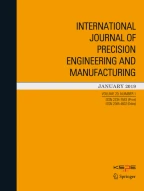Abstract
In this paper, a position and orientation detection method for the capsule endoscopes devised to move through the human digestive organs in spiral motion, is introduced. The capsule is equipped with internal magnets and flexible threads on their outer shell. It is forced to rotate by an external rotating magnetic field that produces a spiral motion. As the external magnetic field is generated by rotating a permanent magnet, the 3-axes Cartesian coordinate position and 3-axes orientation of the capsule endoscopes can be measured by using only 3 hall-effect sensors orthogonally installed inside the capsule. However, in this study, an additional hall-effect sensor is employed along the rotating axis at a symmetrical position inside the capsule body to enhance measurement accuracy. In this way, the largest position detection error appearing along the rotating axis of the permanent magnet could be reduced to less than 15mm, when the relative position of the capsule endoscope to the permanent magnet is changed from 0mm to 50mm in the X-direction, from −50mm to +50mm in the Y-direction and from 200mm to 300mm in the Z-direction. The maximum error of the orientation detection appearing in the pitching direction ranged between −4° and +15°.
Similar content being viewed by others
Abbreviations
- B m :
-
magnetic flux density of permanent magnet
- B X , B Y , B Z :
-
orthogonal components of B m
- B r :
-
residual induction
- θ :
-
rotational angle of permanent magnet
- E :
-
error equation for detecting minimum in error contours
- x p , y p , z p :
-
position of capsule endoscope
- α, β, γ:
-
rotational angles of capsule endoscope
- R XYZ (γ, β, α):
-
rotation matrix for capsule orientation
References
Sendoh, M., Ishiyama, K. and Arai, K.-I., “Fabrication of Magnetic Actuator for Use in a Capsule Endoscope,” IEEE Trans. on Magnetics, Vol. 39, No. 5, pp. 3232–3234, 2003.
Olympus Co., “Medical Device Guidance System,” US Patent, No. 20060063974, 2006.
Wei, Z., Yingjun, C. and Ping, H., “Study on the System of a Capsule Endoscope Driven by an Outer Rotational Magnetic Field,” Proc. of the 2nd Int. Conf. on IEEE/ASME, pp. 1–5, 2006.
Dongmei, C., Chao, H., Lei, W. and Max, Q.-H. M., “Active Actuation System of Wireless Capsule Endoscope Based on Magnetic Field,” IEEE Int. Conf. on ROBIO, pp. 99–103, 2007.
Schlageter, V., Besse, P.-A., Popovic, R. S. and Kucera, P. “Tracking System with Five Degrees of Freedom Using a 2D-Array of Hall Sensors and a Permanent Magnet,” Sensors and Actuators A: Physical, Vol. 92, No. 1–3, pp. 37–42, 2001.
Prakash, N. M. and Spelman, F. A., “Localization of a Magnetic marker for GI Mobility Studies: An In Vitro Feasibility Study,” Proc. of the 19th Int. Conf. of the IEEE EMBS, pp. 2394–2397, 1997.
Yabukami, S., Kikuchi, H., Yamaguchi, M., Arai, K. I., Takanishi, K., Itagaki, A. and Wako, N., “Motion Capture System of Magnetic Markers Using Three-Axial Magnetic Field Sensor,” IEEE Trans. on Magnetics, Vol. 36, No. 54, pp. 3646–3648, 2000.
Wang, X., Meng, M. Q.-H. and Chan, Y., “A Low-Cost Tracking Method Based on Magnetic Marker for Capsule Endoscope,” Proc. of 2004 Int. Conf. on Information Acquisition, pp. 524–526, 2004.
Nagaoka, T. and Uchiyama, A., “Development of a small wireless position sensors for medical capsule device,” Proc. of the 26th Annual Int. Conf. of the IEEE EMBS, pp. 2137–2140, 2004.
Eugene, P., Ichiro, S. and Eduard, L., “A New Method for Magnetic Position and Orientation Tracking,” IEEE Trans. on Magnetics, Vol. 37, No. 4, pp. 1938–1940, 2001.
Lee, J. S., Kim, B. and Hong, Y. S., “A Flexible Chain-based Screw Propeller for Capsule Endoscopes,” Int. J. Prec. Eng. Manuf., Vol. 10, No. 4, pp. 27–34, 2009.
Kim, M. G., Hong, Y. S. and Kang, H., “Position Detection of Capsule Endoscopes Propelled by Its Spiral Motion,” Int. Symp. on Robotics, pp. 216–221, 2008.
Furlani, E., “Permanent Magnet and Electromechanical Devices,” Academic Press, 2001.
Park, J. B., Kang, H. and Hong, Y. S., “Position Detection of a Capsule-Type Endoscope by Magnetic Field Sensors,” J. of KSPE, Vol. 24, No. 6, pp. 66–71, 2007.
John, J. C., “Introduction to Robotics: Mechanics and Control,” Prentice Hall, 2004.
Author information
Authors and Affiliations
Corresponding author
Rights and permissions
About this article
Cite this article
Kim, MG., Hong, YS. & Lim, EJ. Position and orientation detection of capsule endoscopes in spiral motion. Int. J. Precis. Eng. Manuf. 11, 31–37 (2010). https://doi.org/10.1007/s12541-010-0004-5
Received:
Accepted:
Published:
Issue Date:
DOI: https://doi.org/10.1007/s12541-010-0004-5
